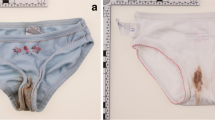Abstract
We evaluated whether anterior genital trauma is associated with urinary incontinence after vaginal birth. A prospective cohort of midwifery patients consented to mapping of trauma at birth and assessment of continence postpartum. Trauma was categorized into intact, anterior (periuretheral, clitoral, labial), perineal or both. Incontinence was defined as a positive response to the question, “Since the birth of your baby, have you leaked urine when you did not mean to?” and social impact assessed by the Incontinence Impact Questionnaire-7 (IIQ-7). Of 554 eligible women, 436 (79%) provided incontinence data 3 months postpartum. Genital trauma was common, occurring in 80% of women: in 148 (34%) trauma was anterior, 119 (27%) had both anterior and perineal trauma and 80(18%) had only perineal trauma. Since delivery, 27% (118/436) women leaked urine. Fewer had IIQ-7 scores greater than 0, at 55/436 (12%). Women with anterior trauma, 29/148 (20%), were less likely to complain of incontinence than all others, 89/288 (31%) (P = 0.01). Urinary incontinence is common after giving birth, although most women have mild symptoms. Anterior trauma is not associated with increased complaints of urinary incontinence.
Similar content being viewed by others
References
Thorp JM Jr, Norton PA, Wall LL, Kuller JA, Eucker B, Wells E (1999) Urinary incontinence in pregnancy and the puerperium: a prospective study. Am J Obstet Gynecol 181:266–273
Burgio KL, Zyczynski H, Locher JL, Richter HE, Redden DT, Wright KC (2003) Urinary incontinence in the 12-month postpartum period. Obstet Gynecol 102:1291–1298
Chaliha C, Kalia V, Stanton SL, Monga A, Sultan AH (1999) Antenatal prediction of postpartum urinary and fecal incontinence. Obstet Gynecol 94:689–694
Viktrup L, Lose G, Rolff M, Barfoed K (1992) The symptom of stress incontinence caused by pregnancy or delivery in primiparas. Obstet Gynecol 79:945–949
Viktrup L, Lose G (2001) The risk of stress incontinence 5 years after first delivery. Am J Obstet Gynecol 185:82–87
King JK, Freeman RM (1998) Is antenatal bladder neck mobility a risk factor for postpartum stress incontinence? Br J Obstet Gynaecol 105:1300–1307
Sultan AH, Kamm MA, Hudson CN (1994) Pudendal nerve damage during labour: prospective study before and after childbirth. Br J Obstet Gynaecol 101:22–28
DeLancey JOL, Kearney R, Chou Q, Speights S, Binno S (2003) The appearance of levator ani muscle abnormalities in magnetic resonance images after vaginal delivery. Obstet Gynecol 101:46–53
Woolley RJ (1995) Benefits and risks of episiotomy: a review of the English-language literature since 1980. Part I. Obstet Gynecol Surv 50(11):806–820
Pregazzi R, Sartore A, Bortolli P, Grimaldi E, Ricci G, Guaschino S (2002) Immediate postpartum perineal examination as a predictor of puerperal pelvic floor dysfunction. Obstet Gynecol 99:581–584
Gainey HL (1943) Post-partum observation of pelvic tissue damage. Am J Obstet Gynecol 45:457–466
Albers LL, Sedler KD, Bedrick EJ, Teaf D, Peralta P (2005) Midwifery care measures in the second stage of labor and reduction of genital tract trauma at birth: A randomized trial. J Midwifery Womens Health 50(5):365–372
Grand A (1989) The choice of suture materials and techniques for repair of perineal trauma: an overview of the evidence from controlled trials. Br J Obstet Gynaecol 96:1281–1289
Ketcham KR, Pastorek JG, Letellier RL (1994) Episiotomy repair: chromic versus polyglycolic acid suture. South Med J 87:514–517
Kettle C, Johanson RB (2000) Absorbable synthetic versus catgut suture material for perineal repair (Cochrane Review). In: The Cochrane Library, issue 4. Update Software, Oxford
Leeman L, Spearman M, Rogers R (2003) Repair of obstetric perineal lacerations. Am Fam Physician 68:1585–1590
Shumaker SA, Wyman JF, Uebersax JS, McClish D, Fantl JA (1994) Health-related quality of life measures for women with urinary incontinence: the Incontinence Impact Questionnaire and the Urogenital Distress Inventory. Continence Program for Women (CPW) Research Group. Qual Life Res 3:291–306
Uebersax JS, Wyman JF, Shumaker SA, McClish DK, Fantl JA (1995) Short forms to assess life quality and symptoms distress for urinary incontinence in women: the Incontinence Impact Questionnaire and the Urogenital Distress Inventory. Continence Program for Women Research Group. Neurourol Urodyn 14:131–139
Hall AF, Theofrastous JP, Cundiff GW, Harris RL, Hamilton LF, Swift SE, Bump RC (1996) Interobserver and intraobserver reliability of the proposed International Continence Society, Society of Gynecologic Surgeons, and American Urogynecologic Society pelvic organ prolapse classification system. Am J Obstet Gynecol 175:1467–1470
Bump RC, Mattiasson A, Bo K, Brubaker LP, DeLancey JO, Klarskov P et al (1996) The standardization of terminology of female pelvic organ prolapse and pelvic floor dysfunction. Am J Obstet Gynecol 175:10–17
Klein MC, Janssen PA, MacWilliam L, Kaczorowski J, Johnson B (1997) Determinants of vaginal–perineal integrity and pelvic floor functioning in childbirth. Am J Obstet Gynecol 176:403–410
Bansal RK, Tan WM, Ecker JL, Bishop JT, Kilpatrick SJ (1996) Is there a benefit to episiotomy at spontaneous vaginal delivery? A natural experiment. Am J Obstet Gynecol 175:897–901
Ecker JL, Tan WM, Bansal RK, Bishop JT, Kilpatrick SJ (1997) Is there a benefit to episiotomy at operative vaginal delivery? Observations over ten years in a stable population. Am J Obstet Gynecol 176:411–414
Carroli G, Belizan J, Stamp G (1999) Episiotomy for vaginal birth. Birth 26:263
Glazener CMA, Herbison GP, MacAuthur, Lancashire R, McGee MA, Grant AM, Wilson PD (2006) New postnatal urinary incontinence: obstetric and other risk factors in primiparae. BJOG 113:208–217
Casey BM, Schaffer JI, Bloom SL, Heartwell SF, McIntire DD, Leveno KJ (2005) Obstetric antecedents for postpartum pelvic floor dysfunction. Am J Obstet Gynecol 192:1655–1662
Persson J, Wolner-Hanssen P, Rydhstroem H (2000) Obstetric risk factors for stress urinary incontinence: a population-based study. Obstet Gynecol 96:440–445
Samselle CM, Miller JM, Mims BL, Delancey JO, Ashton-Miller JA, Antonakos CL (1998) Effect of pelvic muscle exercise on transient incontinence during pregnancy and after birth. Obstet Gynecol 91:406–412
Author information
Authors and Affiliations
Corresponding author
Rights and permissions
About this article
Cite this article
Rogers, R.G., Leeman, L.M., Kleyboecker, S. et al. Is anterior genital tract trauma associated with complaints of postpartum urinary incontinence?. Int Urogynecol J 18, 1417–1422 (2007). https://doi.org/10.1007/s00192-007-0373-1
Received:
Accepted:
Published:
Issue Date:
DOI: https://doi.org/10.1007/s00192-007-0373-1




